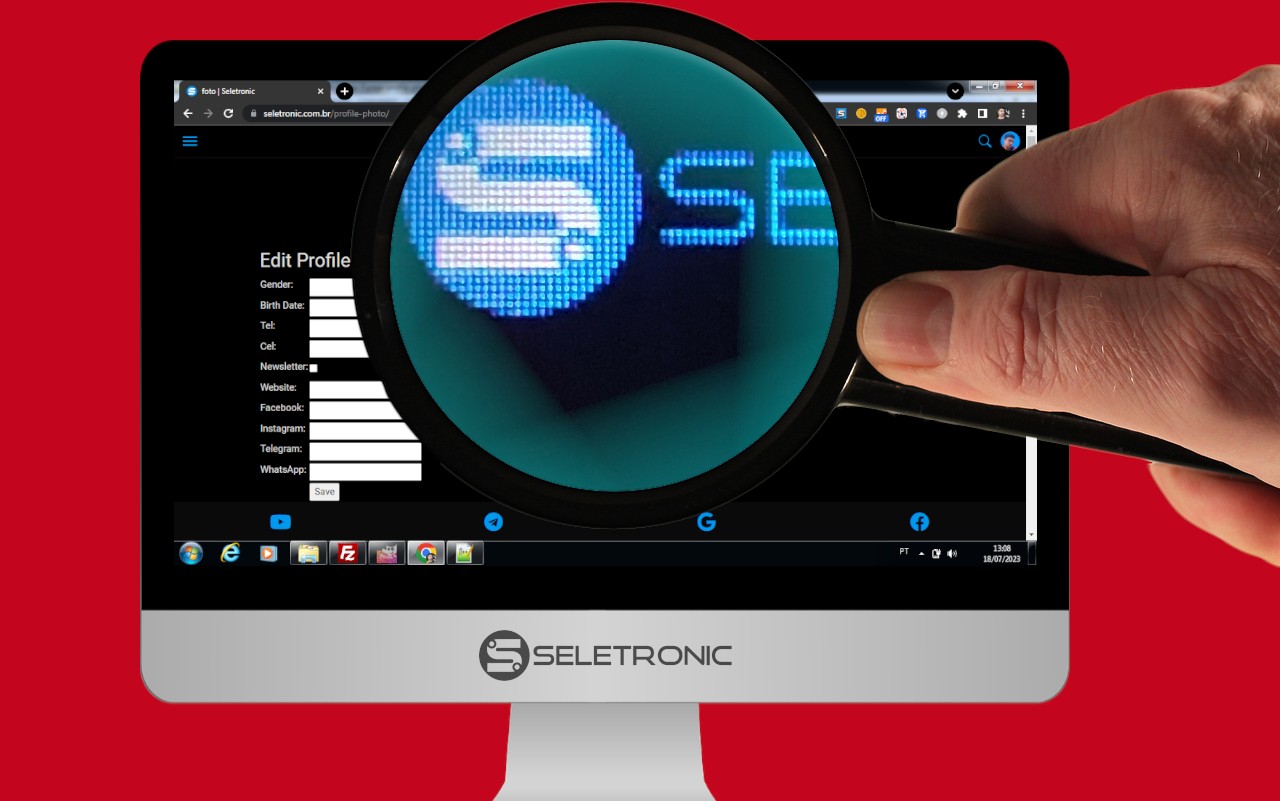What is Pixel? Understand everything!
Understand what pixels are in images, videos, screens and cameras
In the digital world we live in, we are constantly surrounded by images on the screens of our computers, cell phones, televisions and other devices. But have you ever stopped to ask yourself how these images are formed? The secret is in something called a “pixel”. In this article, we will delve into the fascinating universe of pixels, understand what they are, how they work and what their role is in our digital lives.
What is a Pixel?
Pixel is the smallest unit of color and luminosity in a digital image. It is like an essential “brick” that forms the entire visual structure of an image. The term “pixel” is a combination of the words “picture” (image) and “element” (element), and represents a discrete point in a two-dimensional grid that makes up the image.
![]()
In other words, a pixel is like a very small “dot” that forms an image on the screen of your computer, cell phone or TV. Digital images are made up of a large number of these colored “dots”. Each pixel has a color and when all the pixels are put together, they form a complete image. The more pixels an image has, the more detailed it is and the sharper it appears. On the other hand, if there are few pixels, the image may be “checkered” and with less detail.
How Do Pixels Work?
Each pixel is made up of three primary colors: red, green and blue (RGB model). The combination of different intensities of these colors creates an infinite variety of tones and colors, allowing the representation of all the images we see on our electronic devices.
Digital images are formed by a matrix of pixels, and the higher the resolution of the image, that is, the more pixels it has, the more detailed and clear the visual representation will be. This resolution is measured in “pixels per inch” (PPI), and you may have heard of terms like HD (High Definition) or 4K, which refer to the different resolutions available.
 What is a pixel on screens?
What is a pixel on screens?
On screens, a pixel is the smallest image display unit. It is an individual point that makes up the entire image displayed on the screen. Each pixel is responsible for emitting light and can represent a specific color.
Digital screens, such as those on computers, smartphones, televisions and tablets, are made up of millions of pixels organized in a two-dimensional grid. These pixels combine to form the image we see on the screen. Each pixel is controlled independently, allowing it to change its color and light intensity to create a complete image.
Monitors have different resolutions, which are determined by the number of pixels that can be displayed in width and height. For example, a common resolution is 1920×1080, indicating that the monitor can display 1920 pixels wide by 1080 pixels high.
The higher the resolution of a screen (that is, the more pixels it has), the more detailed and sharp the image will be. On the other hand, screens with lower resolution can result in images that are less detailed and less clear, and can show the so-called “pixelated effect”, where individual pixels are visible and the image appears to be made up of small blocks.
What is a pixel in a camera? (megapixels)
In the camera, a pixel is a small photosensitive cell that captures light and converts it into digital information, forming the photographic image. Digital cameras have an image sensor made up of millions of pixels, each of which corresponds to a point in the final image.
When you take a photo, the light that enters the lens is directed towards the camera sensor. Each pixel on the sensor records the amount of light reaching its area and converts it into a digital value, representing a specific color and intensity. These values are combined to create the complete image that you see in the viewfinder or on the camera screen.
The number of pixels on a sensor is known as the camera’s “resolution”, and is measured in megapixels (millions of pixels). The higher the camera’s resolution, the more detail the image will have, allowing for greater magnifications or greater sharpness in images viewed on larger screens.
Keep in mind that resolution is not the only factor determining image quality. Other factors, such as sensor size, lens quality, and camera processing power, also play an important role in obtaining high-quality photographs.
Pixel resolution in videos
Online video sites like YouTube offer various video resolution options to suit users’ different internet capabilities and devices. The most common resolutions include:
- 240p:
- Resolution: 426×240 pixels
- It is a very low resolution, suitable for slow internet connections or older devices. Image quality is poor and details are limited.
- 360p:
- Resolution: 640×360 pixels
- It’s also a low quality resolution, but it offers a slightly better image than 240p. It is useful for slightly faster internet connections.
- 480p (SD – Standard Definition):
- Resolution: 854×480 pixels
- It is a standard resolution, which provides decent image quality for most viewing on smaller screens, such as smartphones and tablets.
- 720p (HD – High Definition):
- Resolution: 1280×720 pixels
- This resolution is high definition and provides a sharp, detailed image, making it ideal for viewing on larger screens such as computer monitors and TVs.
- 1080p (Full HD – Full High Definition):
- Resolution: 1920×1080 pixels
- Offers image quality that is even sharper and more detailed than 720p. It is recommended for viewing on larger screens and high-quality devices.
- 1440p (2K):
- Resolution: 2560×1440 pixels
- It is a higher resolution, suitable for high-quality computer monitors and larger screens. Allows for a more detailed image in videos recorded in high resolution.
- 2160p (4K – Ultra High Definition):
- Resolution: 3840×2160 pixels
- It is a very high quality resolution, which offers extremely clear and detailed images. Recommended for 4K devices and high-end displays.
- 4320p (8K):
- Resolution: 7680×4320 pixels
- It is the highest resolution available on YouTube and other video sites, offering the best image quality possible. However, few videos are available in this resolution due to their extremely high nature and large file sizes.
What does pixel mean in Portuguese?
In Portuguese, “pixel” is a word that represents the same idea and concept as in English. The term “pixel” is an abbreviation for “picture element”, and its use is widely adopted in Portuguese to refer to the smallest unit of color and light in a digital image. Therefore, the word “pixel” does not undergo a specific translation into Portuguese, being commonly used in the same way as in English.
How big is a pixel?
The size of a pixel is not fixed as it varies depending on the device it is being used on and the resolution of the screen or camera sensor.
On computer monitors, smartphones, tablets and televisions, the size of a pixel is determined by the screen’s pixel density, measured in “pixels per inch” (PPI or DPI – Dots Per Inch). The higher the pixel density, the smaller the physical size of each pixel on the screen. For example, on high-resolution screens, such as Apple’s Retina Display or screens with 4K technology, the size of each pixel is very small, which provides sharper and more detailed images.
On the other hand, in digital cameras, the size of a pixel is determined by the size of the image sensor. Cameras with larger sensors typically have larger pixels, while cameras with smaller sensors have smaller pixels. This also influences image quality, as sensors with larger pixels tend to capture more light and perform better in low-light conditions.
Thus, there is no fixed size for a pixel, but rather variations depending on the device and technology used. On modern, high-resolution devices, pixels can be very small, while on older or lower-resolution devices, they can be relatively larger.
